F-spondin/spon1b expression patterns in developing and adult zebrafish
- PMID: 22768035
- PMCID: PMC3387172
- DOI: 10.1371/journal.pone.0037593
F-spondin/spon1b expression patterns in developing and adult zebrafish
Abstract
F-spondin, an extracellular matrix protein, is an important player in embryonic morphogenesis and CNS development, but its presence and role later in life remains largely unknown. We generated a transgenic zebrafish in which GFP is expressed under the control of the F-spondin (spon1b) promoter, and used it in combination with complementary techniques to undertake a detailed characterization of the expression patterns of F-spondin in developing and adult brain and periphery. We found that F-spondin is often associated with structures forming long neuronal tracts, including retinal ganglion cells, the olfactory bulb, the habenula, and the nucleus of the medial longitudinal fasciculus (nMLF). F-spondin expression coincides with zones of adult neurogenesis and is abundant in CSF-contacting secretory neurons, especially those in the hypothalamus. Use of this new transgenic model also revealed F-spondin expression patterns in the peripheral CNS, notably in enteric neurons, and in peripheral tissues involved in active patterning or proliferation in adults, including the endoskeleton of zebrafish fins and the continuously regenerating pharyngeal teeth. Moreover, patterning of the regenerating caudal fin following fin amputation in adult zebrafish was associated with F-spondin expression in the blastema, a proliferative region critical for tissue reconstitution. Together, these findings suggest major roles for F-spondin in the CNS and periphery of the developing and adult vertebrate.
Conflict of interest statement
Figures
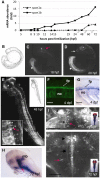


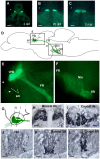
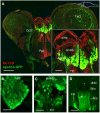
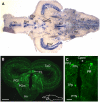
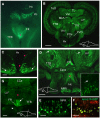


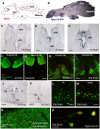
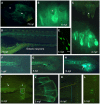
Similar articles
-
Patterns of spon1b:GFP expression during early zebrafish brain development.BMC Res Notes. 2020 Jan 7;13(1):14. doi: 10.1186/s13104-019-4876-x. BMC Res Notes. 2020. PMID: 31910899 Free PMC article.
-
Mindin/F-spondin family: novel ECM proteins expressed in the zebrafish embryonic axis.Dev Biol. 1997 Dec 15;192(2):211-27. doi: 10.1006/dbio.1997.8760. Dev Biol. 1997. PMID: 9441663
-
Transgenic zebrafish recapitulating tbx16 gene early developmental expression.PLoS One. 2011;6(6):e21559. doi: 10.1371/journal.pone.0021559. Epub 2011 Jun 24. PLoS One. 2011. PMID: 21720556 Free PMC article.
-
Genetic tools for multicolor imaging in zebrafish larvae.Methods. 2013 Aug 15;62(3):279-91. doi: 10.1016/j.ymeth.2013.07.028. Epub 2013 Jul 22. Methods. 2013. PMID: 23886907 Review.
-
Bioelectricity in Developmental Patterning and Size Control: Evidence and Genetically Encoded Tools in the Zebrafish Model.Cells. 2023 Apr 13;12(8):1148. doi: 10.3390/cells12081148. Cells. 2023. PMID: 37190057 Free PMC article. Review.
Cited by
-
Adult Neurogenesis: A Story Ranging from Controversial New Neurogenic Areas and Human Adult Neurogenesis to Molecular Regulation.Int J Mol Sci. 2021 Oct 25;22(21):11489. doi: 10.3390/ijms222111489. Int J Mol Sci. 2021. PMID: 34768919 Free PMC article. Review.
-
Neurotransmitter map of the asymmetric dorsal habenular nuclei of zebrafish.Genesis. 2014 Jun;52(6):636-55. doi: 10.1002/dvg.22785. Epub 2014 May 8. Genesis. 2014. PMID: 24753112 Free PMC article.
-
Patterns of spon1b:GFP expression during early zebrafish brain development.BMC Res Notes. 2020 Jan 7;13(1):14. doi: 10.1186/s13104-019-4876-x. BMC Res Notes. 2020. PMID: 31910899 Free PMC article.
-
Developmental neuroanatomy of the rosy bitterling Rhodeus ocellatus (Teleostei: Cypriniformes)-A microCT study.J Comp Neurol. 2022 Aug;530(12):2132-2153. doi: 10.1002/cne.25324. Epub 2022 Apr 25. J Comp Neurol. 2022. PMID: 35470436 Free PMC article.
-
The single-cell transcriptional landscape of mammalian organogenesis.Nature. 2019 Feb;566(7745):496-502. doi: 10.1038/s41586-019-0969-x. Epub 2019 Feb 20. Nature. 2019. PMID: 30787437 Free PMC article.
References
-
- Bénard C, Hobert O. Looking beyond development: maintaining nervous system architecture. Current topics in developmental biology 87: 175–194. 2009. Available: http://www.ncbi.nlm.nih.gov/pubmed/19427520. Accessed 16 August 2011. - PubMed
-
- Feinstein Y, Klar A. The neuronal class 2 TSR proteins F-spondin and Mindin: a small family with divergent biological activities. The International Journal of Biochemistry & Cell Biology 36: 975–980. 2004. Available: http://www.ncbi.nlm.nih.gov/pubmed/15094111. Accessed 7 February 2010. - PubMed
-
- Woo W-M, Berry EC, Hudson ML, Swale RE, Goncharov A, et al. The C. elegans F-spondin family protein SPON-1 maintains cell adhesion in neural and non-neural tissues. Development (Cambridge, England) 135: 2747–2756. 2008. Available: http://www.pubmedcentral.nih.gov/articlerender.fcgi?artid=2633776&tool=p.... Accessed 6 November 2011. - PMC - PubMed
-
- Klar A, Baldassare M, Jessell TM. F-spondin: a gene expressed at high levels in the floor plate encodes a secreted protein that promotes neural cell adhesion and neurite extension. Cell 69: 95–110. 1992. Available: http://www.ncbi.nlm.nih.gov/pubmed/1555244. Accessed 7 February 2010. - PubMed
-
- Schubert D, Klar A, Park M, Dargusch R, Fischer WH. F-spondin promotes nerve precursor differentiation. Journal of Neurochemistry 96: 444–453. 2006. Available: http://www.ncbi.nlm.nih.gov/pubmed/16300627. Accessed 11 February 2010. - PubMed
Publication types
MeSH terms
Substances
LinkOut - more resources
Full Text Sources
Other Literature Sources
Medical
Molecular Biology Databases

